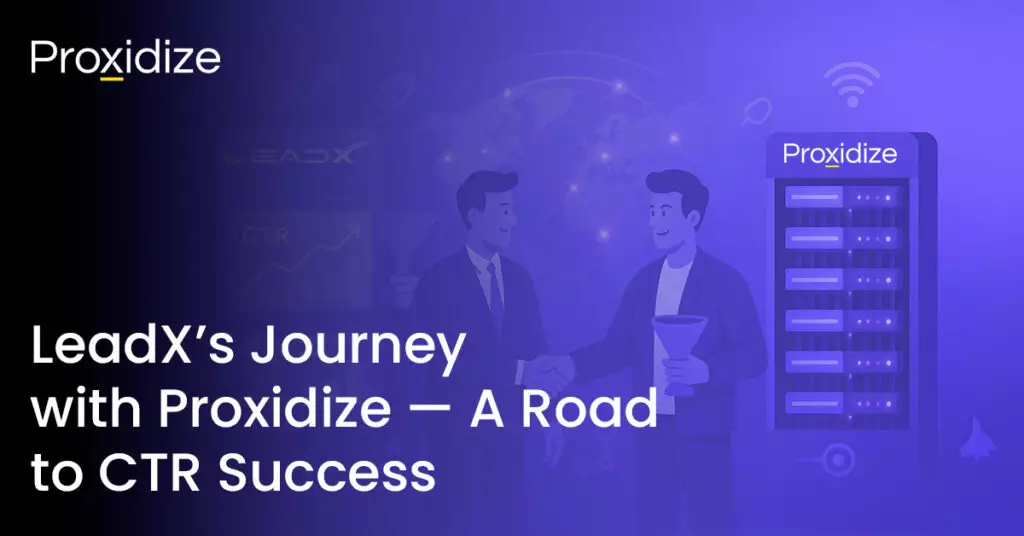Whenever you search for free proxies, you’ll come across open proxy lists, regularly maintained by several different companies. An open proxy is a proxy server that anyone on the internet can use without authentication. Usually, they’re the result of incorrect setup.
Open proxies can be accessed by anyone because they lack access restrictions or security controls, i.e. no username/password. Some open proxies are intentionally set up as public services while others become open due to misconfiguration.
For example, someone might have set up a Squid proxy server with default settings, leaving it accessibly to the entire internet. A lack of access control is a common mistake and can lead otherwise private proxies to become a free-for-all.
In this article we’ll answer the question “What is an open proxy?”, explore where they’re sourced from, what types there are, and discuss their pros and cons.
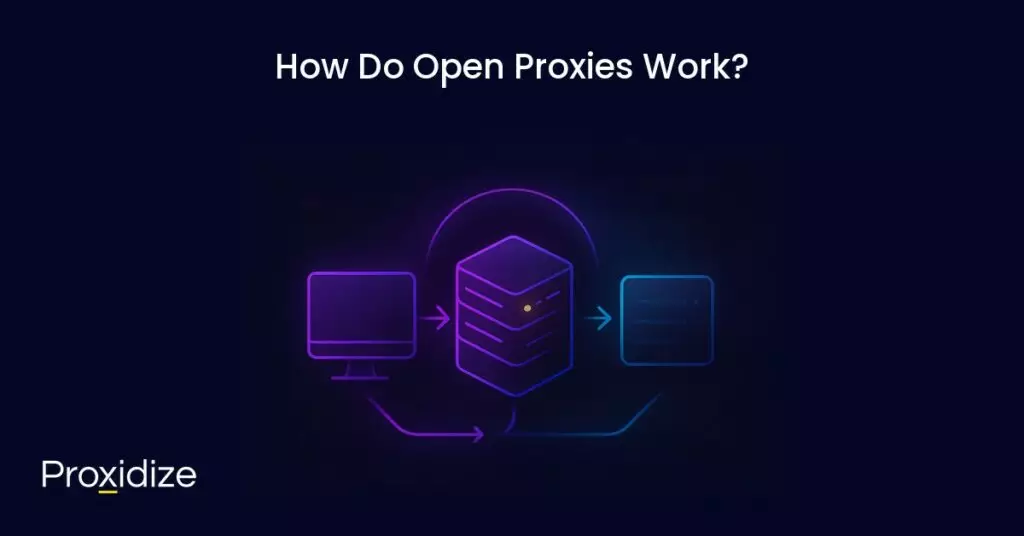
How Do Open Proxies Work?
As with all (most) proxies, when you connect to the internet through an open proxy, the proxy server intercepts the web request and then communicates with the destination server on your behalf.
The sequence is as follows:
- Your device (client) sends a request (for example, to access a website) to the proxy’s IP address and port instead of directly to the website.
- The open proxy, acting as an intermediary server, receives this request and forwards it to the target remote server that hosts the website. To the target server, the request appears to be coming from the proxy’s network address rather than your device.
- The target server (also referred to as the backend server or origin server) then sends the response (the requested webpage or data) back to the proxy.
- Finally, the proxy relays that response back to the user’s browser. Throughout this process, the proxy is effectively masking the user’s real IP address: the destination only sees the proxy server’s IP as the source of the web request, not yours.
Open Proxy Lists
Open proxy lists are databases of publicly available proxy servers anyone can use without authentication. These lists contain IP addresses and their port numbers, country location, anonymity level (which is a dubious metric at best), and protocol type (HTTP, HTTPS, SOCKS4, or SOCKS5). Most lists also show you the uptime percentage, latency measurements, and the last time someone checked if the proxy worked.
The lists come in TXT, JSON and CSV files, which makes them easy to include into scripts. You can filter them according to your needs and plug them into your bot.
How Open Proxy Lists are Sourced
Several methods help create open proxy lists. The main approach uses automated scanning of IP ranges worldwide to look for common open proxy ports like 3128, 8080, and 8000. These scanning bots check entire IP ranges systematically (like 195.000.000.000 through 195.254.254.254) to find responsive ports.
Web scraping serves as another popular method. Scripts automatically gather proxy information from various online sources that collect free proxies. Many proxy list providers keep their databases fresh through constant verification. They check proxies every few minutes in some cases. Some services even test their proxies every 15 minutes to build reliable, current collections.
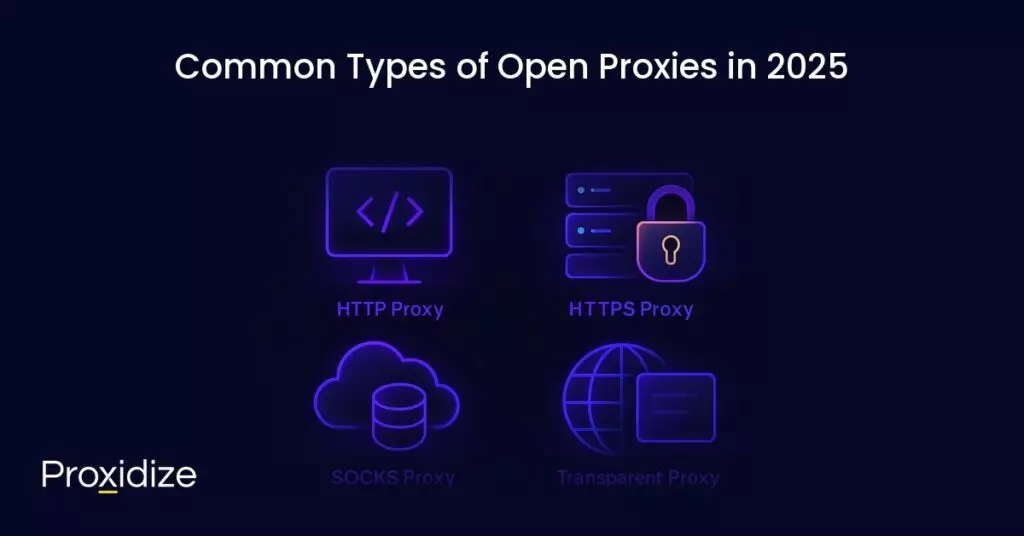
Common Types of Open Proxies in 2025
Here are the main types of open proxies advertised online, each with its own features and uses:
- “Anonymous” proxy: The server’s open port will broadcast the fact it’s a proxy but won’t show websites your IP.
- Transparent proxy: Does not anonymize your IP address at all.
- “High anonymity” proxy: Claims to give you the best protection by hiding all your information before connecting to websites.
- HTTP/HTTPS proxies: Can handle both HTTP and HTTPS traffic between itself and the target server
- SOCKS proxies: SOCKS proxies are protocol-agnostic, meaning they can handle various types of internet traffic.
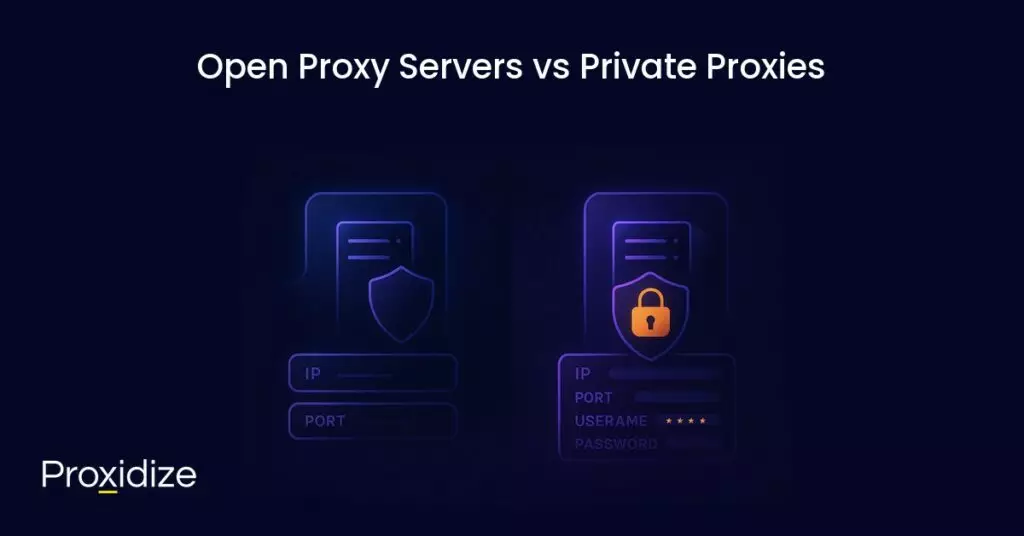
Open Proxy Servers vs Private Proxies
Open proxies are “open” because they don’t require any authentication to use. They’re not password protected and anyone can use them — all you need is the IP address and the port number.
Private proxies are proxy servers that require authentication to use. To access a private proxy, you need its IP address, port number, username, and password.
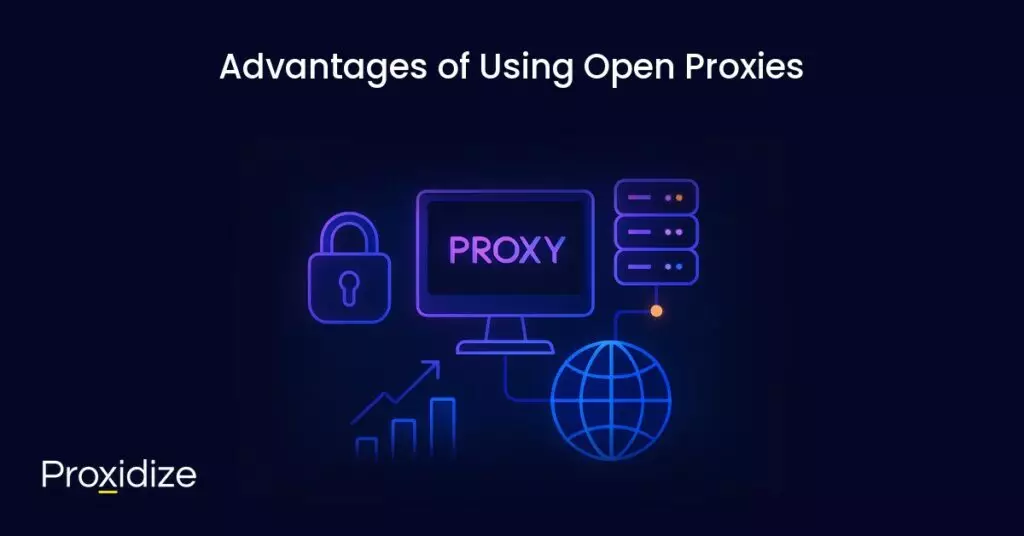
Advantages of Using Open Proxies
Open proxies have several appealing benefits despite their many risks, which explain why they are widely used:
- Easy Public Access: Open proxies are readily available for free. All you have to do is look up an open proxy list. They don’t require you to log in or sign up, cost no money, and are immediately usable.
- Anonymity: Any website you visit will only see the open proxy’s IP address, not your actual IP address.
- Bypassing IP Bans: If you’ve been IP banned, rate limited, or are hit with any other limited access based on IP, a proxy will give you a way around that ban.
- Web Scraping and Automation: Proxies are a convenient, free way to scale up web scraping and automation tools and bots that crawl websites or collect data. An open proxy is a convenient way to test your script before you buy a dedicated proxy. By rotating IP addresses, you can spread your requests making it look like multiple different people and not one bot.
- Bypassing Content Filtering and Censorship: You can access websites and content that would otherwise be geo-restricted (i.e. Netflix, TikTok, etc.)
- They’re Free: Despite their usually awful performance, they don’t cost any money, making them very appealing in a pinch.

Risks and Drawbacks of Open Proxies
While open proxies are undeniably convenient, there are considerable risks. We have a whole article dedicated to why you shouldn’t use free proxies, but here are some of the biggest risks when using an open proxy server:
- No Real Privacy: All the traffic that passes through an open proxy can be visible to its operator — every request you make can be monitored.
- Content Injection: Bad actors operating a free proxy can inject scripts and content into websites before it reaches the user. This can be anything from advertising to much more serious viruses and malware.
- Limited Effectiveness: Just as companies that compile open proxy lists trawl the internet for open proxies, websites — specifically cybersecurity and anti-bot companies — trawl the internet for the lists. Open proxies are quickly identified and added to blacklists, which means you’re far more likely to be IP banned, rate limited, and slapped with CAPTCHAs.
- Poor Performance: As with any free product on the internet, open proxies often suffer from their own success, i.e. from awful performance. With so many users sharing the same proxy server, the connection time slows to a crawl. They’re free and have no guarantees of uptime or speed. Odds are your connection will be dropped more than it’s working.
- Misuse, Abuse, and Legal Concerns: An open proxy’s IP address is effectively shared among as many users as can connect to it, which includes fraudsters, spammers, and bad actors.
- Lack of Support: There are no guarantees of quality with open proxies, because they’re mostly incorrectly set up or community services. Misconfiguration comes with its own host of performance and security concerns on its own.
Conclusion
In this article we covered what open proxies are, how they work, and what makes them so appealing. Open proxies offer a free, publicly accessible way for people to hide their IP address online.
Key Takeaways:
- Open proxies are publicly available proxy servers.
- Lists of open proxies are maintained (and updated as often as hourly) but several websites.
- Open proxies are popular because they’re free and require no setup.
- Open proxy servers are very low quality proxies. They are immediately added to blacklists and are very slow.
- Bad actors can use open proxies to inject viruses and malware.
However, open proxy servers also come with a range of downsides, too, because open proxies are typically sourced from incorrectly set up proxies. With so many people connecting to them, they suffer from poor performance — often to unusable levels. Alongside terrible performance, open proxy servers present a whole host of security risks that severely outweigh any benefit to be gained from them.

